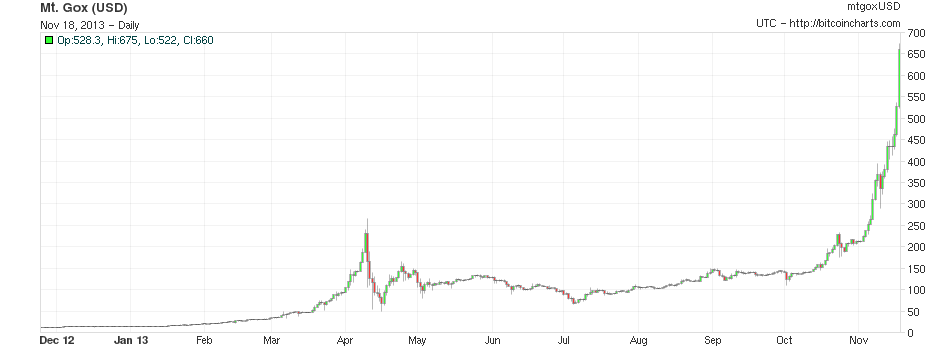The Dow Jones Industrial Average rising above 16,000 for the first time ever was the big market story Monday, but traders were also buzzing about bitcoins.
Bitcoin prices rose above $600 on Monday to log their own all-time high.
Yet few investors truly understand the virtual currency and how it works.
What is bitcoin and how is it created? Here are a few key bullet points on the virtual currency, culled from recent notes from ConvergEx Group:
-
“No one is in charge of bitcoin. The name of the person who wrote the technical specifications which serve as the system’s backbone — Satoshi Nakamoto — is a pseudonym for person or persons unknown. Bitcoin’s transaction record, known as the block chain, sits on thousands of servers around the world and every ten minutes the whole system re-synchs to a commonly accepted list of recent transaction. Bottom line: no one government, or even 100 governments, can ‘Shut down’ bitcoin or establish uniform regulations for the currency.”
-
“Bitcoin issuance is very slow relative to traditional currencies. The reason that the people running these servers dedicate time and money to the effort revolves around bitcoin ‘mining.’ This process involves solving a cryptographic puzzle during the 10 minute window and delivering your answer to everyone else in the system. Accomplish that task and you currently get 25 new bitcoins (about $3,000) for your effort. The puzzles adjust in difficulty so they always take about 10 minutes to solve. Bottom line: the bitcoin ecosystem is dominated by very proficient computer programmers and hardware designers, but even as they improve the speed and efficiency of their servers the universe of available bitcoins still only grows by 25 units every 10 minutes.”
-
“There will never be more than 21 million bitcoins, and there are only 12 million currently.”
So, bitcoin is not backed by a country, unlike existing currencies. Users of bitcoin are a diverse lot, including techies, individuals suspicious of governments and central banks, investors who want currency diversification, and even criminals. For example, the U.S. government seized bitcoins when it took down online black market Silk Road earlier this year.
Bitcoin prices soared more than 20% on Monday following a Bloomberg report that the SEC and the Department of Justice informed a U.S. Senate Committee the virtual currency is a legitimate financial instrument. Federal Reserve Chairman Ben Bernanke in a letter to Congress said bitcoin and virtual currencies “may hold long-term promise, particularly if the innovations promote a faster, more secure and more efficient payment system.”
The U.S. Senate Committee on Homeland Security and Governmental Affairs was holding a hearing on Monday afternoon on virtual currencies.
Bitcoin, which is about four years old, is shaping up to be a top financial story of 2013. The total value of all bitcoins is more than $7 billion, according to Bitcoin Watch. The crypto-currency started the year at $13.55 and traded as high as $675 on Monday, according to bitcoin exchange Mt.Gox. That’s an increase of nearly 5,000% as the virtual currency continues to rally after briefly crashing in April 2013.
The incredible performance of bitcoin this year is naturally causing more investors to look into the story, but it may be hard for the digital currency to maintain its breakneck pace. It’s still relatively difficult to get bitcoin — indeed, the scarce supply partly explains the rally. Bitcoin will eventually have to develop a lot more infrastructure to be a useful global currency, ConvergEx Group notes. Above all, the price can be extremely volatile so most should content themselves with watching this interesting development in financial markets from the sidelines, at least for now.
Chart source: Bitcoin Charts
Photo Credit: btckeychain
Disclaimer: All investments involve risk and various investment strategies will not always be profitable. Past performance does not guarantee future results.






